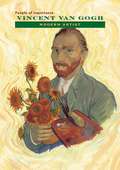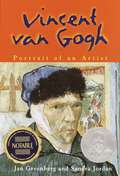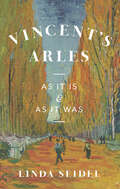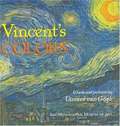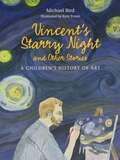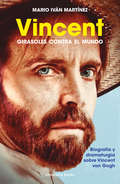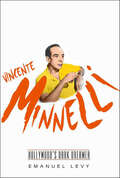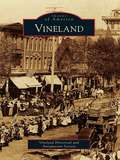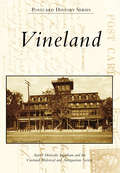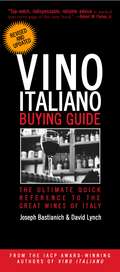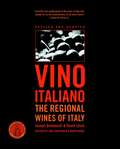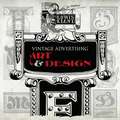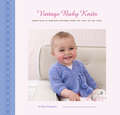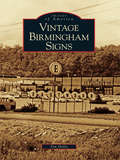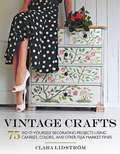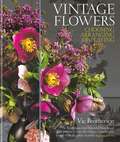- Table View
- List View
Vincent van Gogh: Modern Artist
by Richard BowenVincent van Gogh is one of the most famous and influential painters who ever lived. His work and the dramatic story of his life have captured the minds of people from around the world for more than a century, inspiring artists and art fans alike. Few artists have had the kind of impact on their art that Vincent van Gogh has had on modern painting. Learn the story of one of the most important artists of all time in Vincent van Gogh: Modern Artist.
Vincent van Gogh: Portrait of an Artist
by Jan Greenberg Sandra JordanVincent van Gogh-- one of the 19th century' s most brilliant artists-- will forever be remembered as the Dutchman who cut off his ear. But this incident only underscores the passion that consumed him-- a passion that, when he took up painting at age 27, infused his work. Whether painting a portrait, a landscape, or a still life, van Gogh sought to capture the vibrant spirit of his subject. It didn't matter that others found his work too unconventional. Van Gogh persevered. And as he moved from the cold climate of Holland to balmy southern France, he pioneered a new technique and style. In a career spanning only a decade, van Gogh painted many great works, yet fame eluded him. This lack of recognition increased his self-doubts and bitter disappointments. Today, however, van Gogh stands as a giant among artists.<P><P> [This text is listed as an example that meets Common Core Standards in English language arts in grades 6-8 at http://www.corestandards.org.]<P> Winner of the Sibert Honor
Vincent's Arles: As It Is and as It Was
by Linda SeidelA vivid tour of the town of Arles, guided by one of its most famous visitors: Vincent van Gogh. Once admired as “a little Rome” on the banks of the Rhône, the town of Arles in the south of France had been a place of significance long before the painter Vincent van Gogh arrived in February of 1888. Aware of Arles’s history as a haven for poets, van Gogh spent an intense fifteen months there, scouring the city’s streets and surroundings in search of subjects to paint when he wasn’t thinking about other places or lamenting his woeful circumstances. In Vincent’s Arles, Linda Seidel serves as a guide to the mysterious and culturally rich town of Arles, taking us to the places immortalized by van Gogh and cherished by innumerable visitors and pilgrims. Drawing on her extensive expertise on the region and the medieval world, Seidel presents Arles then and now as seen by a walker, visiting sites old and new. Roman, Romanesque, and contemporary structures come alive with the help of the letters the artist wrote while in Arles. The result is the perfect blend of history, art, and travel, a chance to visit a lost past and its lingering, often beautiful, traces in the present.
Vincent's Arles: As It Is and as It Was
by Linda SeidelA vivid tour of the town of Arles, guided by one of its most famous visitors: Vincent van Gogh. Once admired as “a little Rome” on the banks of the Rhône, the town of Arles in the south of France had been a place of significance long before the painter Vincent van Gogh arrived in February of 1888. Aware of Arles’s history as a haven for poets, van Gogh spent an intense fifteen months there, scouring the city’s streets and surroundings in search of subjects to paint when he wasn’t thinking about other places or lamenting his woeful circumstances. In Vincent’s Arles, Linda Seidel serves as a guide to the mysterious and culturally rich town of Arles, taking us to the places immortalized by van Gogh and cherished by innumerable visitors and pilgrims. Drawing on her extensive expertise on the region and the medieval world, Seidel presents Arles then and now as seen by a walker, visiting sites old and new. Roman, Romanesque, and contemporary structures come alive with the help of the letters the artist wrote while in Arles. The result is the perfect blend of history, art, and travel, a chance to visit a lost past and its lingering, often beautiful, traces in the present.
Vincent's Colors
by Vincent GoghVan Gogh's descriptions, arranged as a simple rhyme, introduce young readers to all the colors of the rainbowand beyond. The descriptive words combine with spectacular reproductions of many of the artist's most beloved and important works to create a perfect art book for young and old alike.
Vincent's Starry Night And Other Stories: A Children's History Of Art
by Kate Evans Michael BirdAn enthralling journey through the story of world art, from early cave paintings right up to the present day. Discover artists and their art around the world, in 68 exciting and imaginative tales about artists and the way they created their work. Written by educator and art historian Michael Bird, and beautifully illustrated by Kate Evans, the book also features reproductions of the famous artworks discussed, a comprehensive timeline of events, and extra feature spreads on places connected with art. This is a beautiful and engaging introduction to art for any home or school library.
Vincent, girasoles contra el mundo: Biografía y dramaturgia sobre Vincent van Gogh
by Mario Iván Martínez«Vincent quiso exorcizar el dolor a través de su arte; la pintura fue el impulso vital que le garantizó la redención.» Hoy en día, Vincent van Gogh es uno de los artistas más admirados y celebrados del mundo. Su nombre evoca pasión, originalidad, genio y, también, una obra valorada en precios exorbitantes. Sin embargo, durante su vida no conoció el éxito y quizá tampoco el amor, a no ser el de su hermano Theo. Este libro explora y recrea este fascinante mito moderno. Vincent, girasoles contra el mundo es una obra doble de Mario Iván Martínez, pues reúne, en un mismo volumen, una biografía del pintor neerlandés y el texto de una obra de teatro que recrea los últimos años de su vida, su relación con su prima Kee, con Sien y con Gauguin, y su muerte. Por su parte, la biografía va revelando la personalidad de Van Gogh a través de su relación con sus padres, de sus descalabros vocacionales (primero como pastor y luego como mercader de arte), de sus fracasos amorosos, de su relación con Theo y con otros artistas. Tanto la biografía como la dramaturgia dan cuenta de una personalidad compleja, a veces contradictoria, y de una sensibilidad exacerbada que, para fortuna de todos, encontró una vía de expresión en el arte. Para el desarrollo de ambos trabajos, Mario Iván Martínez llevó a cabo no sólo una amplia investigación, sino, sobre todo, una profunda inmersión en la vida de Vincent van Gogh.
Vincente Minnelli: Hollywood's Dark Dreamer
by Emanuel LevyVincente Minnelli, Hollywood's Dark Dreamer is the first full-length biography of Vincente Minnelli, one of the most legendary and influential directors in the twentieth century, encompassing his life, his art, and his artistry. Minnelli started out as a set and costume designer in New York, where he first notably applied his aesthetic principles to the Broadway stage design of Scheherazade. He became the first director of New York's Radio City Music Hall, as well as some of the most lavish Broadway musicals, including Ziegfeld Follies, and brought Josephine Baker back from Paris to star in his shows. As a film director, he discovered Lena Horne in a Harlem nightclub and cast her in his first movie, the legendary musical Cabin in the Sky. The winner of the Director Oscar for Gigi, the first film to win in all nine of its Oscar nominations, Minnelli directed such classics as the Oscar-winning An American in Paris, Meet Me in St. Louis, Father of the Bride, The Bad and the Beautiful, and Some Came Running. He was married to Judy Garland, who he met on the set of Meet Me in St. Louis and directed in such landmark films as The Clock; their daughter is actress-singer Liza Minnelli.
Vinci i concorsi online: una guida per concorrenti
by David FuentesDavid Fuentes è stato un concorrente di successo per molti anni, vincendo un sacco di premi e migliaia di sterline di materiale gratuito, tutto dal semplice clic di un pulsante. Ha iniziato con il sogno di vincere la sua strada verso le ricchezze. Ora è una forza da non sottovalutare, vincendo la crema dei gadget e dei gadget indispensabili per il raccolto, mentre sta facendo esperienza di molti premi che non possono essere acquistati. Dopo anni di apprendimento dei trucchi del mestiere, ora ha compilato questa guida per aiutare quelli di voi che vorrebbero fare proprio questo, per seguire le sue orme e aprire la strada a piaceri indicibili. Il mondo è un'ostrica di concorsi; dove troverai la tua perla?
Vineland
by Vineland Historical and Antiquarian SocietyIn the mid-1800s, Charles K. Landis, a visionary and entrepreneur, was looking for land that would be more adaptable to fruit than to grain and suitable also for a wide range of industries. In 1861, Landis developed a parcel of land just north of Millville. Landis set aside 1 square mile called the Borough of Vineland exclusively for homes, businesses, and industry. Beyond that 1 square mile, the land was designated for farming and became Landis Township. In 1952, the citizens of the borough and township voted to merge the two into the City of Vineland, which today remains the largest city in area in New Jersey. Known for its cultural and religious diversity, Vineland's success in farming, business, and industry can be traced to its unique blend of early settlers, natives, and immigrants alike.
Vineland (Postcard History Series)
by Vineland Historical and Antiquarian Society Arjorie Moniodis IngrahamIn 1861, Charles K. Landis carved the village of Vineland from the western edge of the Pine Barrens. The community quickly attracted a diverse population who farmed and manufactured. A network of railroads enabled the town to ship its produce and products to markets along the East Coast. Vineland was recognized as a cultural mecca as well as a center of civil rights and women's suffrage. Physically the largest "small town" in New Jersey in square miles, Vineland today still attracts newcomers in search of new opportunities, just as Landis hoped for all those years ago.
Vinificação para novatos
by Kyle Richards Elen CantoSe você é um especialista ou apenas gosta de provar um vinho de vez em quando, Vinificação para novatos é o guia perfeito para proporcionar-lhe o orgulho e o prazer de fabricar seu próprio vinho! Não se intimide pelos hectares de uvas e galpões com maquinários que encontramos nas vinícolas. Você pode fazer vinho em casa, e este e-book lhe mostra como! Não precisa ter experiência, pois dividimos o processo em passos simples para que qualquer um consiga fazer um vinho delicioso e cheiroso em casa enquanto se diverte! Compartilhe com sua família e amigos ou guarde para uma ocasião especial. É um muito gratificante dar de presente uma garrafa de vinho que você fez para um amigo ou ente querido. Quem nunca fez vinho costuma ter as seguintes dúvidas: · Que tipo de uva devo usar? · Qual é o equipamento necessário? · Quanto ele custa? · É difícil fazer vinho em casa? · Como ele é feito? Este e-book responde a essas e outras perguntas. Com nosso simples processo, seu vinho preferido logo terá seu nome no rótulo! Chega de pesquisar vinhos misteriosos e caros nas intermináveis prateleiras das adegas. Vinificação para novatos vai permitir que você comece a fazer seu vinho imediatamente. Baixe já seu exemplar!
Vinnie Ream: An American Sculptor
by Edward CooperAn intriguing biography of the American woman sculptor and Civil War–era Washington, DC, fixture. One of America&’s least known and most controversial women artists of the Civil War era was Vinnie Ream, who sculpted a bust of Abraham Lincoln from life when she was only sixteen years old and had almost no artistic training. She was able, through clever maneuvering and dogged determination, to achieve a commission from the Congress for a life-sized statue of the assassinated president—this despite the very real animus against women artists at that time, which is apparent in the heated arguments against granting her the Lincoln commission—arguments spearheaded in the Senate by Charles Sumner of Massachusetts. Steeped in the history of her time, Vinnie Ream was involved with dozens of senators and congressmen and other powerful men—not least of all Generals Sherman and Custer—and her studio on Capitol Hill became a legendary stopping place for many admirers and tourists. Her statue of Lincoln stands in the rotunda of the capitol building; her statue of Admiral Farragut stands in a Washington, DC, park; other works are in Statuary Hall and various museums. This is an engaging biography of a spirited female artist, and an effective portrait of Washington, DC, in the Civil War era. Praise for Vinnie Ream &“Ream&’s intellect, artistic talents, indomitable will, seductiveness, and grand ambitions were already evident when she was a teenager newly arrived in Washington, D.C. in 1861. . . . Endlessly intriguing. . . . Kudos to Cooper for resurrecting Ream and enriching so vividly the history of women in art.&” —Booklist&“A sharply focused biography, which skillfully exploits unpublished papers, journals and scrapbooks of Vinnie Ream.&” —New York Review of Books
Vino Italiano Buying Guide - Revised and Updated: The Ultimate Quick Reference to the Great Wines of Italy
by David Lynch Joseph BastianichAn updated companion volume to Vino Italiano provides a convenient, consumer's guide to Italian wine, listing high-quality Italian wines that are available in the United States along with information about the winemaker, ratings of the wineries, d
Vino Italiano: The Regional Wines of Italy
by David Lynch Joseph BastianichAt one time, Italian wines conjured images of cheap Chianti in straw-wrapped bottles. More recently, expensive "Super Tuscans" have been the rage. But between these extremes lay a bounty of delicious, moderately priced wines that belong in every wine drinker's repertoire.Vino Italiano is the only comprehensive and authoritative American guide to the wines of Italy. It surveys the country's wine-producing regions; identifies key wine styles, producers, and vintages; and offers delicious regional recipes. Extensive reference materials--on Italy's 300 growing zones, 361 authorized grape varieties, and 200 of the top producers-- provide essential information for restaurateurs and wine merchants, as well as for wine enthusiasts.Beautifully illustrated as well as informative, Vino Italiano is the perfect invitation to the Italian wine experience.
Vintage Advertising Art and Design
by DoverHere are all the essentials for creating striking ads and other graphic messages with an attention-getting retro look and feel. Drawn from typographic sourcebooks as well as sign-painting manuals of the early twentieth century, this comprehensive volume includes a wealth of borders, frames, images, and typographic elements for re-creating authentic styles of the 1890s-1920s. An inexhaustible source of inspiration for artists, illustrators, and crafters, these versatile designs will add an antique touch to any project, including scrapbooks and other memory albums.
Vintage Baby Knits: More Than 40 Heirloom Patterns from the 1920s to the 1950s
by Kristen RengrenThe longtime knitter and vintage fashion expert puts a contemporary twist on classic knit babywear in this beautifully photographed pattern book. While working as a vintage clothing dealer, combing through estate sales and eBay listings, longtime knitter Kristen Rengren amassed hundreds of knitting pattern booklets from 1920 through 1960. Now a knitwear designer, Rengren brings us the result of her combined passions in Vintage Baby Knits, a charming collection of more than 40 contemporary updates of timeless baby patterns. Projects range from small, quick-to-knit items like hats, booties, and shrugs to larger, more challenging designs for sweaters, onesies, and dresses, including a lace christening gown. Beautiful photographs capture a bevy of adorable babies and toddlers wearing these knitted treasures. Also included are sidebars on baby fashion and knitting culture in this bygone era, and a complete reference section. Destined to be a classic itself, Vintage Baby Knits promises family heirlooms for 21st-century babies. This is a fixed-format ebook, which preserves the design and layout of the original print book.
Vintage Baby Knits: More Than 40 Heirloom Patterns from the 1920s to the 1950s
by Kristen RengrenThe longtime knitter and vintage fashion expert puts a contemporary twist on classic knit babywear in this beautifully photographed pattern book. While working as a vintage clothing dealer, combing through estate sales and eBay listings, longtime knitter Kristen Rengren amassed hundreds of knitting pattern booklets from 1920 through 1960. Now a knitwear designer, Rengren brings us the result of her combined passions in Vintage Baby Knits, a charming collection of more than 40 contemporary updates of timeless baby patterns. Projects range from small, quick-to-knit items like hats, booties, and shrugs to larger, more challenging designs for sweaters, onesies, and dresses, including a lace christening gown. Beautiful photographs capture a bevy of adorable babies and toddlers wearing these knitted treasures. Also included are sidebars on baby fashion and knitting culture in this bygone era, and a complete reference section. Destined to be a classic itself, Vintage Baby Knits promises family heirlooms for 21st-century babies.
Vintage Birmingham Signs
by Tim HollisMost people do not stop to realize how many of their fond memories involve advertising signs. Although these neon spectaculars, billboards, and even signs painted directly onto brick walls were created expressly to persuade customers to buy products or patronize businesses, many such signs remained in place for so long that they became beloved landmarks in their own right. For Images of America: Vintage Birmingham Signs, Tim Hollis has scoured the archives of Birmingham's former sign companies, as well as other private collections, to compile some of the best remembered or most obscure signs that dotted the urban and suburban landscape. Here readers will again see the Buffalo Rock bottle pouring its ginger ale into a glass, the Golden Flake clown smiling down at passersby, the Barber's milk clock at the Five Points South intersection, and many more. Through these vintage photographs, readers can once again visit such once-thriving destinations as Eastwood Mall, Burger in a Hurry, and the Kiddieland amusement park.
Vintage Crafts: 75 Do-It-Yourself Decorating Projects Using Candles, Colors, and Other Flea Market Finds
by Clara LidströmVintage flair isn't just classy and cute; it's fun to create and perfect for any budget! So let your creativity run wild on trips to the flea market, and don't back down from that deal at the yard sale. With Vintage Crafts, use paper scraps, teacups, and a splash of paint to decorate your house room by room.More than just a craft book, Vintage Crafts features recipes fresh from the countryside, lessons for safe and easy outdoor improvement, and tips for keeping your house eco-friendly. This is the ultimate home decor resource from Sweden's number one lifestyle blogger, Clara Lidström. Learn to liven up secondhand clothes, turn old fabrics into patchwork projects, and interject some '50s-era chic into your thrift store finds.Elegant, old-style country projects include:Champagne box bookshelvesWallpapering with mapsSilhouette framesBaby shoe flower plantersBark and twig lanternsAnd so much more to make with your two hands and flea market bargains!So look around: if your house is full of scraps and never-used knickknacks, turn them into something beautiful, useful, and made by you! With Vintage Crafts at your crafting table, your hands will never be idle again!
Vintage Crochet For Your Home: Best-Loved Patterns for Afghans, Rugs and More
by Coats ClarkCrochet that's both vintage and modern!Bring the look of the 1920s to 1950s into your home with 30 fabulous designs from the Coats & Clark archives. Whether you enjoy outfitting your rooms in totally retro style or are just adding a beautiful accent from the past to traditional or modern décor, Vintage Crochet for Your Home is full of ideas. From potholders and dishcloths to rugs and afghans, each design has the charm of the original but with modern twist, as each pattern has been re-created using today's terms and in yarns and threads you can easily find. A basics section for those new to crochet or in need of a refresher is included in the book to help ensure success. And stitch diagrams in addition to written instruction allow you to create the projects in the way that works best for you.With projects for the kitchen, dining and entertaining, bed and bath and, of course, a wonderful collection of throws and afghans, you'll give your home one-of-a-kind style with Vintage Crochet for Your Home.
Vintage Fashion & Couture: From Poiret to McQueen
by Kerry Taylor"I thought I knew almost everything about the history of fashion until I met Kerry Taylor. The inside-out knowledge she has of garments will inspire both students and designers to look at fashion with fresh eyes." - Sarah Mower, US Vogue "This beautiful book by Kerry Taylor - the go-to woman for vintage and antique couture - is a treat for collectors and fashion lovers alike." - The Wall Street Journal"Whatever my question about vintage, Kerry Taylor has the answer. Her expertise, knowledge and historical anecdotes have raised the level of interest in this subject hugely." -Lisa Armstrong, Daily Telegraph Named one of Glamour Magazine's "Must-Read Style Books"! Profiled by Vogue and The New York Times and courted by style icons with wardrobes to sell and top designers in search of inspiration, Kerry Taylor is one of the world's leading experts on vintage fashion and couture. In this lavishly illustrated book, Kerry tells the story of a century of fashion through the work of its key design talents and the memorable women who have worn their creations. All the fashion stars are here from Poiret to McQueen via Lanvin, Chanel, Schiaparelli, Madame Grès, Dior, Balenciaga, Mary Quant, Ossie Clark, Vivienne Westwood, Alaïa, and Margiela. For each designer Kerry explores their career through a dazzling range of clothes and accessories, explaining what makes each item so desirable to the collector or wearer of vintage fashion. Each chapter includes at least one 'style icon' whose relationship with fashion has had a lasting impact, including Baba D'Erlanger, Lauren Bacall, Grace Kelly, Catherine Deneuve, Paloma Picasso and Kate Moss. Illustrated with a mix of gorgeous fashion photography plus images from Kerry's own astonishing archive, this book is set to become an invaluable guide for collectors of vintage (whatever their budget) and all those who love fashion.Contents includes...Foreword by Hubert de GivenchyPrologue by Christopher Kane1900sPaul PoiretLucileMariano Fortuny1920sJean PatouJeanne LavinChanel in the Twenties1930sElsa SchiaparelliStyle Icon Wallis SimpsonMadeleine Vionnet - The Architect of Couture1940sThe effects of War on Fashion in EuropeAmerican Fashion in the FortiesChristian Dior - The Saviour of French Haute Couture1950sPierre BalmainCristóbal Balenciaga - The MasterStyle Icon Grace Kelly1960sMary QuantHubert de Givenchy Style Icon Audrey Hepburn1970sYves Saint Laurent in the SeventiesZandra RhodesVivienne Westwood and Malcolm McLaren1980sItalian MastersAzzedine AlaïaJohn Galliano1990sThe New RomanticsThierry MuglerStyle Icon Kate Moss2000sLater McQueenStyle Icon Daphne GuinnessCollecting VintageTaking Care of your Collection..And so much more!
Vintage Fashion Accessories
by Stacy LoalboLooking for a great way to add character, class and individuality to your wardrobe, without breaking the bank on a whole new outfit? Look no further than vintage accessories to take the outfits from functional to historically fabulous! With retro and vintage being all the rage, every great wardrobe can always use vintage accessories, even if it's just a few timeless pieces. Vintage Fashion Accessories is your guide to making the most of vintage accessories and showing off your fashion and collecting sense in what you wear. You may be surprised at how a $12 hat from the 1960s, $6 pair of vintage gloves and a $15 patent leather-look handbag can make your ensemble look like a million bucks, but with Vintage Fashion Accessories in hand it will quickly begin to make sense. In this beautifully illustrated book you'll discover more than 1,000 color photos of hats, handbags, jewelry, shoes, compacts, scarves, hankies, belts and more. Plus there's a chapter on accessories for the debonair gentleman. This fun and stylish gateway of retro fashion also features: History of fashion and accessories and current values Tips on the joy of collecting and fun of the hunt The best places to shop for first-rate items Fashionista or collector you'll discover helpful and historical details about vintage accessories that you can use to punch up your wardrobe and stand out from the crowd.
Vintage Flowers
by Vic BrothersonBeautiful and romantic, Vic Brotherson's flower arrangements focus on traditional, seasonal blooms and foliage, such as alchemilla, lavender, hellebore, peonies and hydrangeas, and perfectly match the vintage pitchers, planters, old glass and retro, charity-shop finds she uses both for displays and as a major source of inspiration. From simple posies to glorious garlands and stunning centrepieces for a Christmas banquet, Vintage Flowers demonstrates just how easy it is to transform a handful of fresh cuttings into arrangements that instantly feel at home and complement the look of a room. Accompanied by step-by-step instructions on using florist foam and chicken wire to making a garland, wreath and hand-tied bunch, plus tips on how to select and condition flowers for longevity, how to pin the perfect corsage, wiring flowers for your hair and how to get the most from your budget, Vintage Flowers promises fabulous results every time.
Vintage Flowers: Zauberhafte Ideen Für Nostalgische Blumenarrangements
by Vic BrothersonBeautiful and romantic, Vic Brotherson's flower arrangements focus on traditional, seasonal blooms and foliage, such as alchemilla, lavender, hellebore, peonies and hydrangeas, and perfectly match the vintage pitchers, planters, old glass and retro, charity-shop finds she uses both for displays and as a major source of inspiration. From simple posies to glorious garlands and stunning centrepieces for a Christmas banquet, Vintage Flowers demonstrates just how easy it is to transform a handful of fresh cuttings into arrangements that instantly feel at home and complement the look of a room. Accompanied by step-by-step instructions on using florist foam and chicken wire to making a garland, wreath and hand-tied bunch, plus tips on how to select and condition flowers for longevity, how to pin the perfect corsage, wiring flowers for your hair and how to get the most from your budget, Vintage Flowers promises fabulous results every time.
